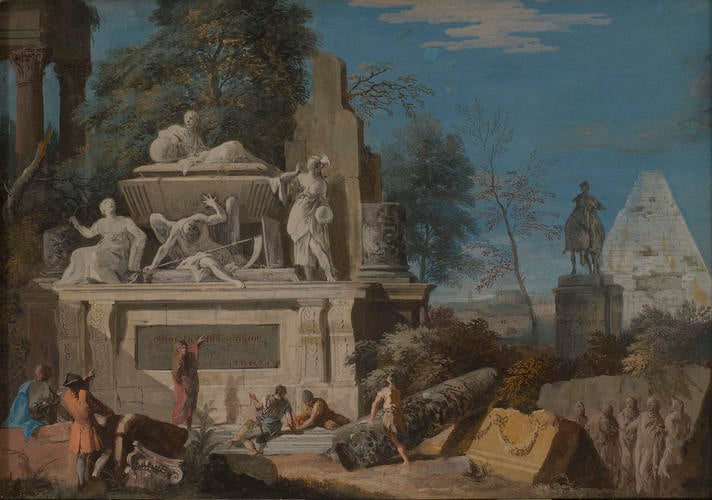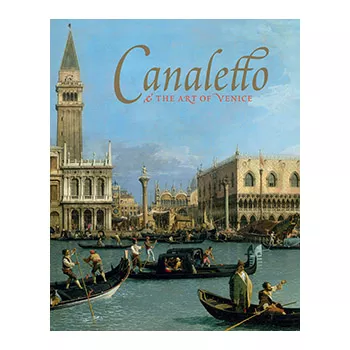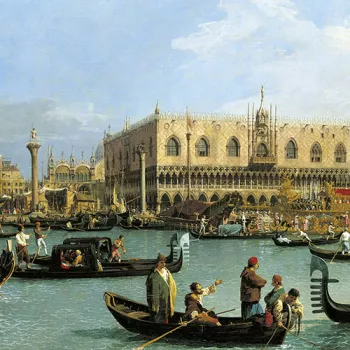Allegory with a Monument to Newton dated 1728
Gouache on leather | 31.8 x 45.5 cm (support, canvas/panel/stretcher external) | RCIN 400585
-
Marco Ricci produced a large number of paintings of landscape subjects executed in the unusual technique of gouache, or perhaps tempera, on leather, possibly kidskin (the paint was made by binding pigments with egg yolk or gum arabic respectively). Typically measuring about 31 × 45 cm, the smooth, pale surface of the skin on the stretcher gives a clarity and luminosity to the bright paint applied to it. Joseph Smith, who knew Marco Ricci well, collected 33 of Ricci's gouache paintings, all but one now in the Royal Collection. All the works are in their original Venetian frames (some have their eighteenth-century glazing intact) and they would have hung in groups, probably on the walls of Smith's residence at Mogliano.
The focus of this caprice landscape is the marble monument to the scientist and mathematician Sir Isaac Newton, which is seen at the left. Newton reclines atop a sarcophagus which is supported by a figure of Time. At the left is seated History or Fame, holding a book and pen. At the right is a standing female figure with wings on her head, probably symbolising scientific and mathematical knowledge. Various figures, some in modern and others in classical dress, stand and sit before the monument. One standing figure points to the inscription on the monument which reads: NON OMNIS MORIR. / MDCCXXVIII. The inscription is a quotation from Horace ('Odes', Book III, no. 30, line 6) which translates as: 'I shall not wholly die' (the last word should read 'moriar').
Marco and Sebastiano Ricci had previously collaborated in painting two of the 'Tombs' in the series Tombeaux des Princes which were commissioned from a variety of Italian painters by Owen MacSwiney (although the 'Tomb' of Newton in this series was painted by Domenico and Giuseppe Valeriani and Pittoni). The design of the monument in this work is noticeably less fantastic and elaborate than the 'Tombs', and is not far in concept from similar designs for monuments by Rysbrack. Sir Isaac Newton (1642-1727) is buried in Westminster Abbey, where his monument was completed in 1731 on William Kent's design, with subtle changes by Rysbrack.The gouache paintings demonstrate the broad range of influences that Marco absorbed. In his early years he came into contact with Alessandro Magnasco and Francesco Peruzzini of Ancona (1668–1706), both of whom worked closely with Sebastiano, and may have met the Dutch artist Pieter Mulier, called 'il Cavalier Tempesta' (c.1637–1701). In his temperas of tempestuous weather conditions and other moments of high drama, such as figures fleeing from a bear, encountering bandits, or monks and hermits praying, Marco was influenced by Salvator Rosa's wild and mountainous landscapes and Magnasco's dark and dramatic style.
Text adapted from Canaletto & the Art of Venice, 2017.
Provenance
Acquired from the artist (or after his death) by Joseph Smith, British Consul in Venice; acquired from Smith by George III in 1762 (Italian List nos 116-48); recorded in the Queen's Dressing Room at Kew in 1805 and 1828
-
Medium and techniques
Gouache on leather
Measurements
31.8 x 45.5 cm (support, canvas/panel/stretcher external)
43.1 x 57.0 x 4.0 cm (frame, external)
Other number(s)
Alternative title(s)
Landscape with an Allegorical Monument to Newton
Landscape with an allegorical monument to Sir Isaac Newton (1642-1727)










